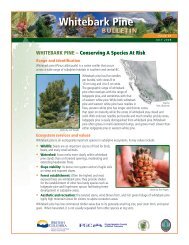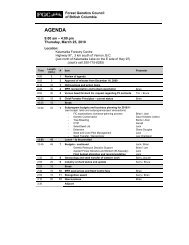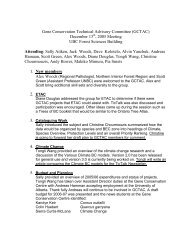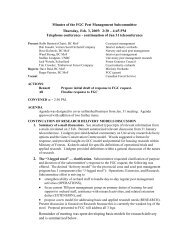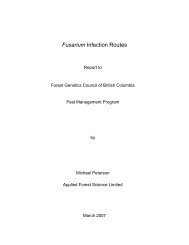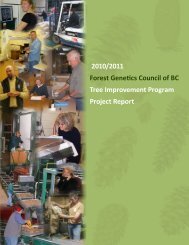Tree Improvement Program Project Report 2006 / 2007
Tree Improvement Program Project Report 2006 / 2007
Tree Improvement Program Project Report 2006 / 2007
You also want an ePaper? Increase the reach of your titles
YUMPU automatically turns print PDFs into web optimized ePapers that Google loves.
crown. If crown pruning helps to re-invigorate the lower<br />
crown, then we may expect lower-crown cones to increase<br />
relative to the control block.<br />
Seed y elds<br />
Figures 44 and 45 show the mean total seed per cone<br />
(TSPC) and filled seed per cone (FSPC) for the three<br />
top-pruned blocks. TSPC and FSPC both declined in the<br />
year following pruning (2005) and increased slightly in<br />
<strong>2006</strong>. Although we would not expect pruning treatments<br />
to produce substantial differences in cone yields, there is a<br />
small, positive indication that yields in the moderate and<br />
severe pruning blocks were higher in <strong>2006</strong>. This result may<br />
indicate that re-invigorating the crowns by top-pruning<br />
improved seed set. We will closely follow this result in the<br />
next few years.<br />
Figures 46 and 47 show the FSPC data from the three<br />
top-pruned blocks by lateral-pruning (Figure 46) and by<br />
Seed Cone Number<br />
Total seed per Cone<br />
Filled Seed per Cone<br />
10<br />
8<br />
6<br />
4<br />
2<br />
0<br />
60<br />
50<br />
40<br />
30<br />
20<br />
10<br />
0<br />
50<br />
40<br />
30<br />
20<br />
10<br />
0<br />
T R E E I M P R O V E M E N T P R O G R A M<br />
2004 2005 <strong>2006</strong><br />
2004 2005 <strong>2006</strong><br />
2004 2005 <strong>2006</strong><br />
P R O J E C T R E P O R T 2 0 0 6 / 2 0 0 7<br />
crown height (Figure 47). Again, FSPC values were slightly<br />
better in the top-pruned blocks, but they were unaffected<br />
by lateral pruning. It is too early to determine if this is a<br />
trend or just a yearly variation. Again, subsequent years’<br />
observations will determine if this is a trend.<br />
Figure 47 shows the difference in seed yields by crown<br />
position. Yields were higher for upper-crown cones, but the<br />
magnitude of the difference was smaller for the moderate<br />
and severely pruned bocks. Again, this may indicate that<br />
lower crowns of top-pruned blocks are more vigorous.<br />
Finally, Figure 48 shows the differences in seed cone<br />
yields by insect protection for each of the three topping<br />
blocks. Although seed loss to insect predation is not<br />
necessarily associated with top-pruning treatments, this<br />
data clearly shows that seed losses in <strong>2006</strong> were in the order<br />
of 10 FSPC. In the two Kalamalka lodgepole pine seed<br />
orchards, insect damage in <strong>2006</strong> was among the highest<br />
ever recorded.<br />
Con<br />
Mod<br />
Sev<br />
Con High<br />
Con Low<br />
Mod High<br />
Mod Low<br />
Sev High<br />
Sev Low<br />
F gure 3. Mean seedcone<br />
counts for a<br />
major whorl branch n<br />
the upper and lower<br />
crown.<br />
F gure . Mean total seed per cone (TSPC).<br />
Con<br />
Mod F gure . F lled seed per cone (FSPC)<br />
Sev for the three top-pruned blocks.



